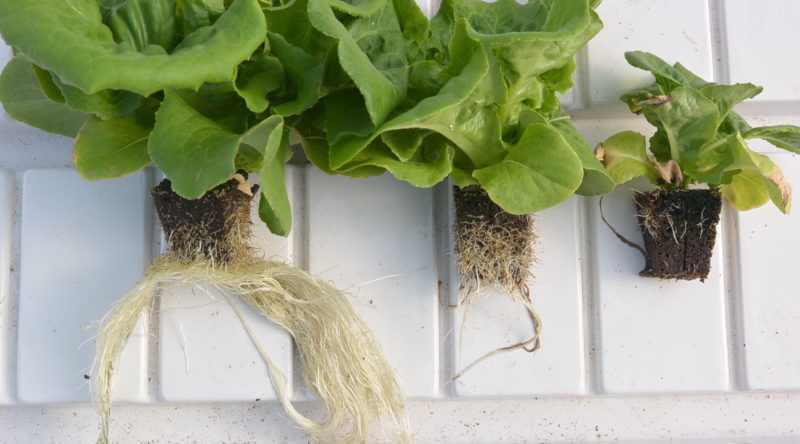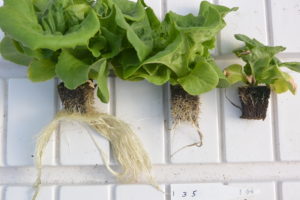
Traditional Versus Hydroponic Fertilizer Practices
Do you know the differences and similarities when it comes to fertilization practices for traditional growing media culture and hydroponic culture?
Joining me today is Cari Peters, vice president of JR Peters, Inc. (Jack’s Fertilizers). Cari earned her bachelor’s degree at the University of Delaware and master’s and Ph.D. degrees at the University of Maryland. She returned to the family business in Allentown, Pennsylvania, in 2004.

Peter: Cari, let’s start by comparing and contrasting fertilization practices for traditional growing media culture and hydroponic culture. At some levels managing crop nutrition in either system is identical, while at other levels it’s very different.
Cari: You hit it right on the nose, Peter, and we hear this type of thing a lot at the JR Peters Lab. What seems like the perfect plan for one person never seems to work seamlessly for another with a similar setup. It is probably no surprise to hear me say that it all does start with water quality. In either system, a simple water analysis will act as a baseline of what you are starting with and what you may or may not have to add to the system to grow healthy plants.
In both situations, we look at water quality but also consider the whole picture — the media type (soilless or hydroponic), the crop and the environment (controlled or traditional). That may seem like a lot, but a conversation about these things while looking at the lab analysis of the water will help us tailor a fertility program that’s just right.
Peter: So for either system, media based or hydroponic, our responsibility to understand the quality of the water source is ground zero. Having a complete water analysis performed at least once and preferably twice a year is standard protocol. And it is not yet old news to differentiate between pH and alkalinity. What else are you seeing from growers regarding media based versus hydroponic production?
Cari: One grower scenario we see frequently is when there is a transition from growing plants in a traditional greenhouse media system to a retrofitted hydroponic setup. Sometimes, to make it even more fun, the two are co-existing not that far from each other. It sounds silly, but an important thing to consider for a fertility program is how you think about plants taking up their nutrients.
Technically, the nutrients still follow the same availability curves as they would in the media. However, plants growing in a hydroponic environment are much more susceptible to pH swings in the nutrient solution. These swings can be buffered by the level of alkalinity in the water source, but they happen much quicker than what we see when growing in a typical media culture pot. The lower the alkalinity (RO or rain water systems are among the lowest), the more susceptible we are to a fertility program causing a pH swing.
Peter: Your comment about a hydroponic environment being more susceptible to pH swings and subsequent nutrient uptake imbalances is similar to what I notice in my water treatment research. Sanitizing products that we use safely from a phytotoxicity perspective in a traditional growing medium are proving to be phytotoxic at the same rates in a hydroponic system.
My reasoning parallels yours; the naked, unprotected roots in a hydroponic system are more sensitive to oxidizing agents and other sanitizing chemicals. Observations in this arena have generated an appreciation for how much buffer protection the growing medium offers the root system, in several ways. Figure 1 shows lettuce plants grown in nutrient film channels after various treatments. The control plant on the left shows a normal, extensive root mass that thrives in the nutrient film. The center and right plants received various treatments that inhibited normal root development and subsequent shoot development. The same treatments delivered to similar plants in a growing medium did not cause phytotoxicity.

Moving on, hydroponic production is often connected to an A/B fertilizer program. While it’s common practice for growers using media based production to also inject more than a single formulation of soluble fertilizer, what is it about hydroponic production that requires an A/B injection system more routinely?
Cari: We find that hydroponic growers generally value having the option of manipulating nutritional inputs when things change. They are aware of their growing environment and how it can affect plant growth. Changes in the environment can be due to many things, one of the most common is the light level either outside (time of year) or indoors (light schedule). Light levels at either extreme can influence plant transpiration.
Low light levels slow the rate of transpiration resulting in reduced nutrient uptake. A grower using an A/B system can easily adjust the Part B injection rate while keeping the Part A steady. This will give the plants a needed 30- to 40-ppm boost of calcium from the Part B while keeping the micronutrient concentration from Part A steady.
Peter: You reference light as one contributing factor to variable growth rate and that having the ability to tailor nutrient delivery is powerful. Growing in a greenhouse under natural light alone can be highly variable due to clouds and weather and season; it makes sense that growth rate variability occurs daily. Adding supplemental light in the greenhouse can eliminate much of the variability and moving indoors without sunlight can be that much more stable with advancing LED technology.
We might conclude that moving along this progression eliminates the need for the A/B system indoors as a result of increased control. But, as you mentioned, variable light level is just one of several environmental factors that affect growth rate. Stage of crop development, particularly for fruiting crops, is another factor requiring flexibility in the nutrient delivery system. If we have multiple reasons for using the A/B approach what challenges does this system present compared to a single formulation-single injector approach?
Cari: One of the most common failures in a Part A and Part B system occurs during the stock concentrate mixing steps. How do you know what nutrients can go into what bucket? It seems quite simple, part A in its own bucket and part B in the other, but what about other additions and boosters. Certain nutrients in the fertilizer world are not compatible with each other and when mixed in high concentrations will precipitate.
The most common culprits for these messy situations are calcium-phosphorus precipitates, when a high phosphorus formula is mixed with a high calcium formula (i.e., Blossom Booster 10-30-20 with calcium nitrate 15.5-0-0). Another common one is when a grower attempts to add a nutrient boost from Epsom salts. When Epsom salts (a magnesium-sulfur source) is mixed with a calcium source in high concertation a messy clump of gypsum (a calcium-sulfur source) magically appears in the bottom of the stock tank. Both of these mixing mistakes are quite common and I often say to growers after making this mess once you will never do it again.
Peter: Next, you and other fertilizer manufacturers have been developing options for replacing an A/B system. How’s that product development going?
Cari: These are the things that make my job exciting, taking a look at how we have done things in the past — we have more than 70 years of formulating in my family here at Jack’s — and reconsidering how to bring improvements to our industry. Our research and development team has been working on many options to not really replace the A/B system, that will always have a place in both a traditional and hydroponic fertility program. Rather, we are introducing blends that make hitting nutrient targets easy and efficient.
These formulas optimize nutrient ratios of the major nutrients (nitrogen, phosphorus and potassium) the secondary (calcium, magnesium and sulfur) and also all the micros. We have come to this place from all the plant tissue, media and solution testing that we do in our on-site laboratory. We find ourselves consistently telling growers to adjust their fertilizer selection with certain additions to grow the most efficient crop of lettuce or tomato or cut flower. When we collect enough of this data we put together formulations and blends that address these needs and make it easy for the end user.
Peter: That’s an excellent point about leveraging all the media, tissue and solution analyses your and other labs have accumulated over many years. An impressive data base continues to evolve; quite a shift has taken place from our “shotgun blast” 20-20-20 days to today’s crop tailored “rifle shot” formulations. My water quality here in New England works well with a 13-2-13 formulation.
Earlier you described the importance of analyzing, monitoring and understanding water quality. Continuing the theme of elevated sensitivity to various factors in hydroponic versus traditional media based production, share your thoughts on pH management. How are growers juggling fertilizer formulation choice and pH adjustment using acid or base in both systems?
Cari: Those two pieces of information are of the utmost importance from a water test. What pH you are starting with and what will your alkalinity do to affect the pH as plants take up water and nutrients. This is where it is valuable to consider a formula’s potential to change the pH around the root zone over time. Each raw nutrient or blended formula will have statement on its label that reflects its potential to change pH over time. Formulas that are potentially acidic will lower the pH, potentially basic will raise the pH and neutral formulas will keep the pH where it originally started. So, to target a certain pH in both a traditional or hydroponic system it is wise to choose a formula that helps go in the direction you need to go and then look at the need to add an acid or a base depending on the total water alkalinity.
Peter: Our conversation ends as it started, acknowledging that as fertilizer technology advances the basic principles of delivering nutrients to crops in traditional or hydroponic systems remain quite similar. That said, a big difference between traditional growing media based systems and hydroponic systems is the lack of buffering on the hydroponic side. Growers need to be more vigilant in monitoring and managing the hydroponic environment to minimize pH and nutrient uptake fluctuations.








 Video Library
Video Library 

















